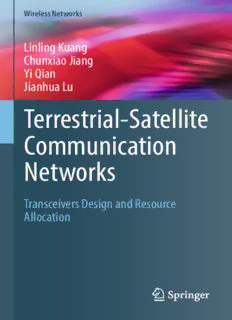Table Of ContentWireless Networks
Linling Kuang
Chunxiao Jiang
Yi Qian
Jianhua Lu
Terrestrial-Satellite
Communication
Networks
Transceivers Design and Resource
Allocation
Wireless Networks
Serieseditor
Xuemin(Sherman)Shen
UniversityofWaterloo,Waterloo,Ontario,Canada
Moreinformationaboutthisseriesathttp://www.springer.com/series/14180
Linling Kuang • Chunxiao Jiang (cid:129) Yi Qian
Jianhua Lu
Terrestrial-Satellite
Communication Networks
Transceivers Design and Resource Allocation
123
LinlingKuang ChunxiaoJiang
TsinghuaSpaceCenter TsinghuaSpaceCenter
TsinghuaUniversity TsinghuaUniversity
Beijing,China Beijing,China
YiQian JianhuaLu
DepartmentofElectrical TsinghuaSpaceCenter
andComputerEngineering TsinghuaUniversity
UniversityofNebraska-Lincoln Beijing,China
Lincoln,NE,USA
ISSN2366-1186 ISSN2366-1445 (electronic)
WirelessNetworks
ISBN978-3-319-61767-1 ISBN978-3-319-61768-8 (eBook)
DOI10.1007/978-3-319-61768-8
LibraryofCongressControlNumber:2017944138
©SpringerInternationalPublishingAG2018
Thisworkissubjecttocopyright.AllrightsarereservedbythePublisher,whetherthewholeorpartof
thematerialisconcerned,specificallytherightsoftranslation,reprinting,reuseofillustrations,recitation,
broadcasting,reproductiononmicrofilmsorinanyotherphysicalway,andtransmissionorinformation
storageandretrieval,electronicadaptation,computersoftware,orbysimilarordissimilarmethodology
nowknownorhereafterdeveloped.
Theuseofgeneraldescriptivenames,registerednames,trademarks,servicemarks,etc.inthispublication
doesnotimply,evenintheabsenceofaspecificstatement,thatsuchnamesareexemptfromtherelevant
protectivelawsandregulationsandthereforefreeforgeneraluse.
Thepublisher,theauthorsandtheeditorsaresafetoassumethattheadviceandinformationinthisbook
arebelievedtobetrueandaccurateatthedateofpublication.Neitherthepublishernortheauthorsor
theeditorsgiveawarranty,expressorimplied,withrespecttothematerialcontainedhereinorforany
errorsoromissionsthatmayhavebeenmade.Thepublisherremainsneutralwithregardtojurisdictional
claimsinpublishedmapsandinstitutionalaffiliations.
Printedonacid-freepaper
ThisSpringerimprintispublishedbySpringerNature
TheregisteredcompanyisSpringerInternationalPublishingAG
Theregisteredcompanyaddressis:Gewerbestrasse11,6330Cham,Switzerland
Preface
Nowadays, mobile service coverage is crucial for economic development. Up to
now, therearestillalargenumber ofpopulation withoutmobileservicecoverage,
especially in less developed areas. Moreover, future wireless networks should
also guarantee service continuity for emerging applications and heterogeneous
networks. On the other hand, the cost of providing ubiquitous coverage has to be
taken into account for mobile network operators. Current urban areas are mainly
coveredbyterrestrialcellularnetworks,whiletheusageofwirelessnetworkinless
developed areas, such as remote rural areas, is far less than urban areas. The cost
of pure terrestrial coverage quickly becomes unbearable with increasing network
requirementsforthoseremoteruralareas.
While the terrestrial networks can provide high-speed data service at low cost,
satellite-based access is one way to complement the terrestrial-based networks for
achieving ubiquitous, 100% geographic coverage. A satellite network is an ideal
solutiontoaddresssuchadilemma.Onesatelliteisabletocoverareasofthousands
ofkilometersinradiusinsteadofseveralkilometerswithaterrestrialbasestation.
The coexistence and cooperation between terrestrial and satellite networks are
of great potential in future communication networks. Therefore, investigations of
innovative technologies in terrestrial-satellite networks are in great need to reveal
theirtruepotentials.
In a typical communication system, transmission and reception are the funda-
mental problems. We consider the technique of beamforming to achieve multiple
access transmission in the terrestrial-satellite network and the interference can-
celation reception to mitigate the inter-beam interference as well as intersystem
interference. Meanwhile, due to the limited spectrum resources, spectrum sharing
will become one critical issue in terrestrial-satellite communication networks,
and efficient spectrum sensing techniques are also worthy of being investigated.
Finally, taking the interference and limited spectrum resources into account, it is
importanttodesignefficientresourceallocationschemestoachieveoptimalsystem
performance.
Recently,arraymulti-beamantennashavedrawnmoreattentionforthepossible
application of digital beamforming techniques, which is an efficient transmitting
v
vi Preface
method for multiple access. By adjusting the weighting factors on antennas, it
can steer nulls to mitigate co-channel interferences and form independent beams
towarddifferentdirections,whichcontributetoimprovetheperformanceofmobile
communication systems. We investigated the technique of beamforming in the
integrated terrestrial and satellite communication systems we also concluded the
main challenges and prospective applications in the integrated terrestrial and
satellite systems. Based on beamforming, we proposed a multimedia multicast
integratedterrestrial-satellitenetwork,inwhichbasestations(BSs)andthesatellite
workcooperativelytoprovideubiquitousserviceforgroundusers.Byservingusers
thatrequirethesamecontentsasagroupusingmulticasting,higherefficiencycan
be achieved. As a practical application of beamforming in satellite networks, we
launched the Smart Communication Satellite (SCS) on 4 Sept. 2014, which is the
firstlowEarthorbit(LEO)mobilecommunicationexperimentalsatelliteofChina,
and the smart beamforming technology was experimented on this satellite. Part of
theseworksisintroducedinChap.2.
In the terrestrial-satellite networks, inter-network interference may become
severewhenreusingthefrequencyinthesystem.Whensatelliteterminalsandbase
stations transmit signals at the same time with the same frequency, it will cause
considerableco-channelinterference(CCI)whichwillsignificantlydeterioratethe
system performance. Based on channel estimation and centralized processing, we
proposed several interference coordination schemes for different scenarios in the
integratedsatelliteandterrestrialnetwork,whichisintroducedinChap.3.
Infifth-generation(5G)networks,millimeter-wave(mmWave)bandshavedrawn
great attention for the large amount of possible bandwidth. Meanwhile, satellite
communications have also shown great interest in the mmWave bands, especially
theKaband.Undersuchacircumstance,duetothelimitationofspectrumresources,
spectrum sharing will become one critical issue in terrestrial-satellite communica-
tion networks. We investigated the problems of spectrum coexistence between the
geostationary(GEO)satellitesystemandterrestrialsystemsandbetweentheGEO
satellite system and the non-geostationary (NGEO) satellite system, respectively.
We first analyzed the interference caused by terrestrial systems and the NGEO
satellite system to the GEO satellite system in two transmission modes and then
introducedtheconceptofprotectionradiustoprotecttheGEOsystem.Then,inthe
scenarioofspectrumcoexistencebetweentheGEOandtheNGEOsatellitesystems,
we investigated the issue of blind spot where spectrum awareness techniques may
failtoidentifythespectrumholes.PartofthisworkisintroducedinChap.4.
The technique of cognitive radio (CR), which enables dynamic access of
spectrum, can improve the utilization rate of the spectrum. To meet the com-
munication need in terrestrial-satellite networks with limited spectrum resources,
we investigated the technique of spectrum sensing in this network. The satellite
systems having the licensed spectrum are considered as primary users, while the
terrestrialsystemsareregardedassecondaryusers.Wefirstadvancedastrategyfor
SUtosearchavailablespectrumswithasynchronousMAC-layersensing.Withthis
method,SUsneednotknowthecommunicationmechanismsinPU’snetworkwhen
dynamicallyaccessing.Then,wediscussedtheasynchronouscooperativespectrum
Preface vii
sensing and derive the optimal sensing parameters under such asynchronous
scenario.Also,weproposedadensitycontrolmechanismformanagingthenumber
of secondary transmitters around one primary receiver in order to guarantee that
primary communications are not interfered. Some important ideas are included in
Chap.5.
In terrestrial-satellite networks, the resource allocation problem, such as spec-
trum resource, time resource, antenna resource, power resource, space resource,
orbit resource, etc., will be more complex due to the coupling between resources
and the interference. Against this issue, we proposed several resource allocation
schemes in different scenarios of terrestrial-satellite communication networks,
which can optimize the capacity performance of the entire system. In order to
protecttheterrestrialusers,weintroducedtheinterferencetemperaturelimitforthe
satellite to control the interference caused to BS users. Furthermore, we proposed
the concept of the cloud-based integrated terrestrial-satellite network (CTSN), in
which both the terrestrial network and the satellite network are connected to the
cloud for centralized resource management. Some interesting results are briefly
presentedinChap.6.
Overall,thisbookaimsatgivingacomprehensivediscussiononthemotivation,
problem formulation, and research methodology on the transceivers’ design and
resourceallocationinfutureterrestrial-satellitecommunicationnetworks.
Beijing,China LinlingKuang
Beijing,China ChunxiaoJiang
Omaha,NE,USA YiQian
Beijing,China JianhuaLu
Acknowledgments
Thanks to all the collaborators who have also contributed to this book. They are
Xiangming Zhu, Boyu Deng, and Yuanzhi Zhong. Meanwhile, we would like to
thankthecontinuedsupportfromtheNationalNaturalScienceFoundationofChina
undergrants91438206,91638205,91538203,61621091,and61371079.
ix
Contents
1 Introduction .................................................................. 1
1.1 Background.............................................................. 1
1.2 IntegratedTerrestrial-SatelliteNetworkArchitecture................. 2
1.3 RelatedResearchandDevelopment.................................... 3
1.4 OrganizationsofthisBook ............................................. 4
1.5 Summary ................................................................ 6
2 BeamformingTransmission................................................. 7
2.1 BeamforminginSatelliteCommunicationSystems................... 7
2.1.1 Multi-BeamJointProcessing .................................. 9
2.1.2 MultigroupPrecoding .......................................... 10
2.1.3 CooperativeBeamforminginTerrestrial-Satellite
Networks........................................................ 12
2.2 MulticastBeamforming................................................. 13
2.2.1 SystemModel................................................... 15
2.2.2 ProblemFormulation........................................... 16
2.2.3 OptimalPowerAllocationAlgorithm ......................... 18
2.2.4 PerformanceEvaluation........................................ 22
2.3 SmartCommunicationSatellite ........................................ 26
2.3.1 SystemDesign.................................................. 27
2.3.2 SmartBeamforming............................................ 28
2.4 Summary ................................................................ 29
References..................................................................... 29
3 InterferenceCancelationReception ....................................... 31
3.1 Position-AssistedInterferenceCoordination .......................... 32
3.1.1 SystemModel................................................... 32
3.1.2 SchemeofInterferenceCoordination.......................... 34
3.1.3 PrecisionAnalysis.............................................. 37
3.1.4 PerformanceEvaluation........................................ 40
3.2 ChannelStateInformationBasedInterferenceCoordination......... 41
3.2.1 ModelandFormulation......................................... 41
xi

